Analysis of firm’s strategic capabilities and external environment
VerifiedAdded on 2023/06/17
|9
|2591
|380
AI Summary
This report provides an evaluation of the internal and external environment of Tesco, a UK-based retail sector organisation. The report includes a SWOT analysis, PESTLE analysis, and Porter’s five forces model to analyse the strategic capabilities and external environment of the organisation.
Contribute Materials
Your contribution can guide someone’s learning journey. Share your
documents today.
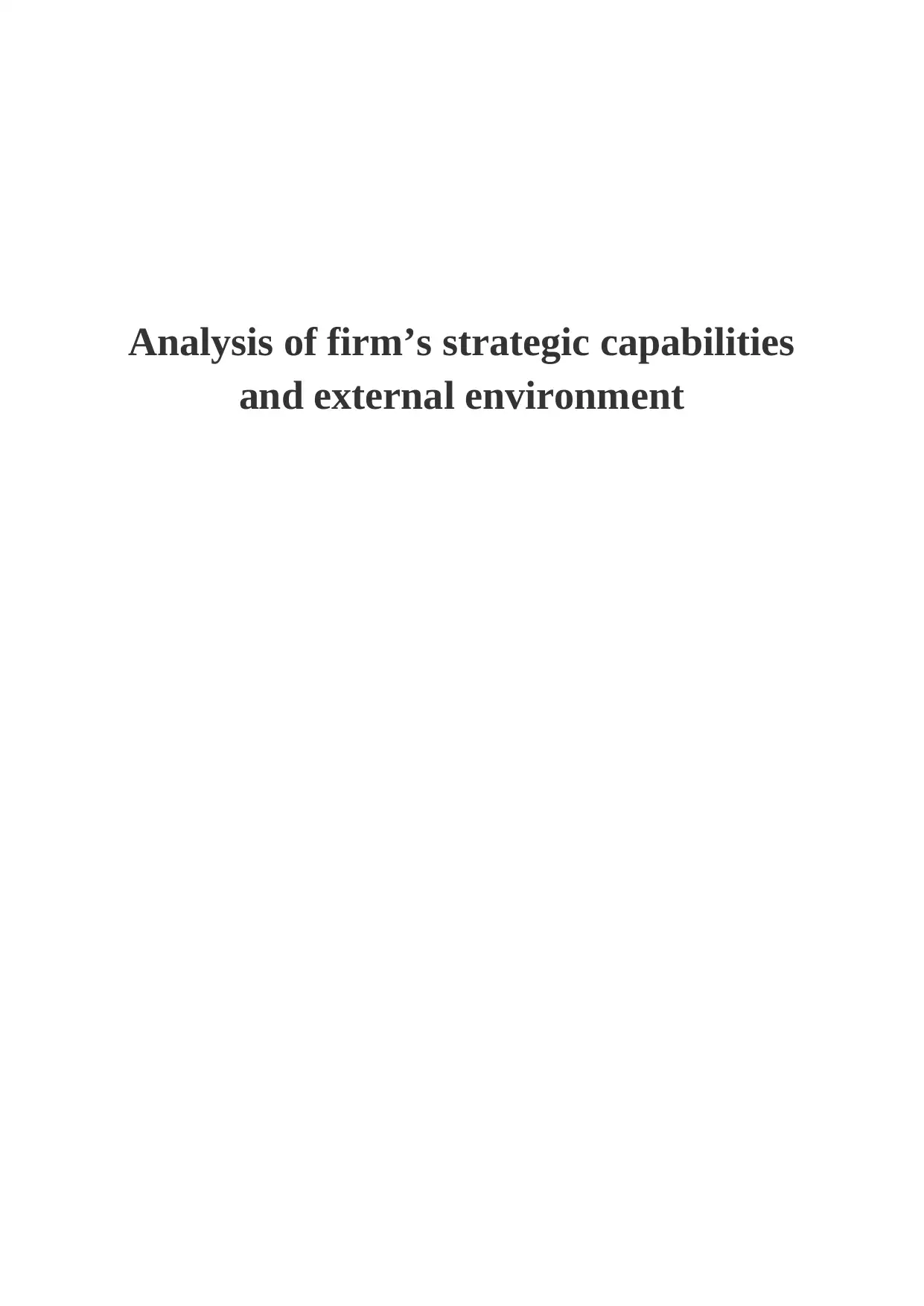
Analysis of firm’s strategic capabilities
and external environment
and external environment
Secure Best Marks with AI Grader
Need help grading? Try our AI Grader for instant feedback on your assignments.
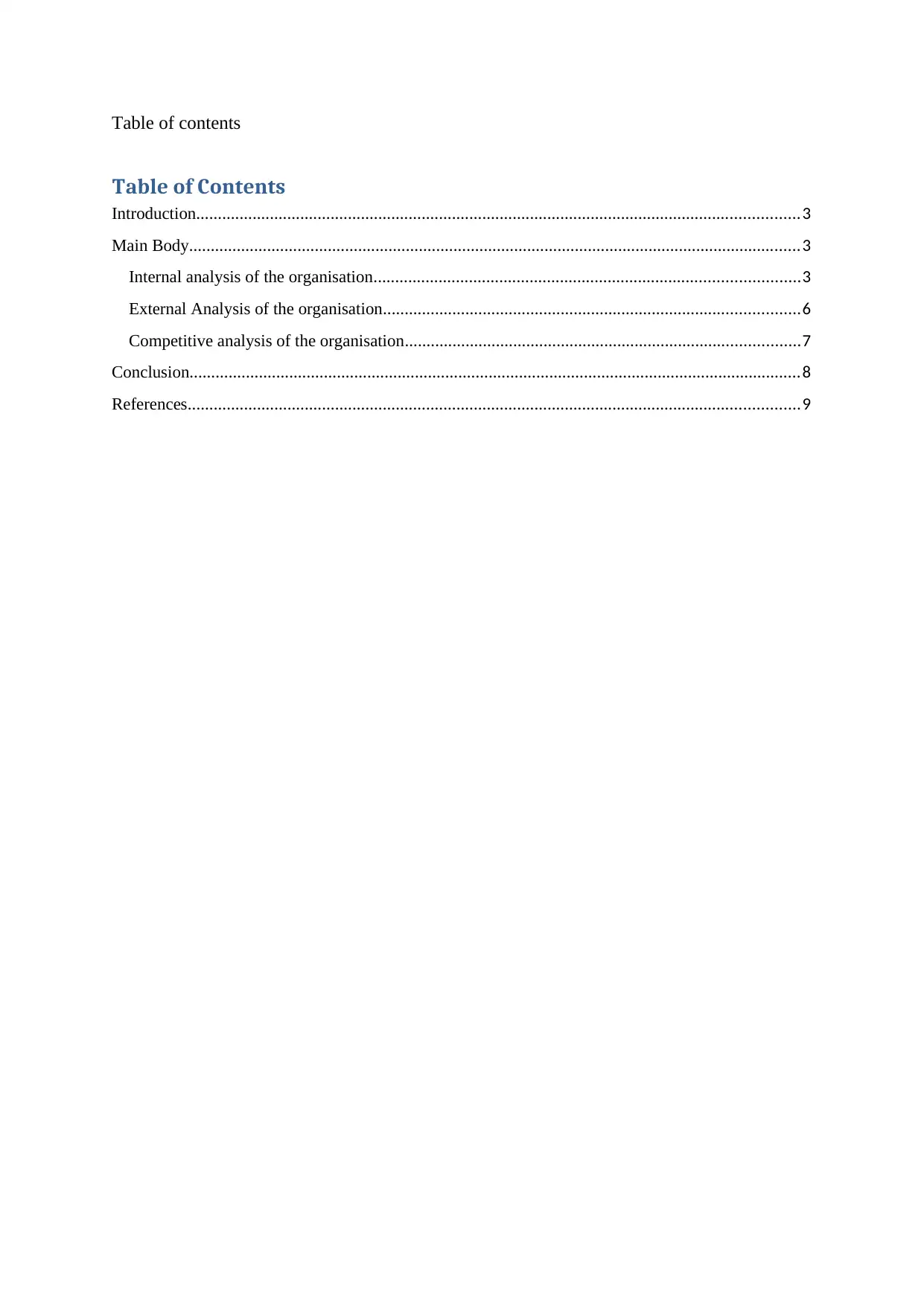
Table of contents
Table of Contents
Introduction...........................................................................................................................................3
Main Body.............................................................................................................................................3
Internal analysis of the organisation..................................................................................................3
External Analysis of the organisation................................................................................................6
Competitive analysis of the organisation...........................................................................................7
Conclusion.............................................................................................................................................8
References.............................................................................................................................................9
Table of Contents
Introduction...........................................................................................................................................3
Main Body.............................................................................................................................................3
Internal analysis of the organisation..................................................................................................3
External Analysis of the organisation................................................................................................6
Competitive analysis of the organisation...........................................................................................7
Conclusion.............................................................................................................................................8
References.............................................................................................................................................9
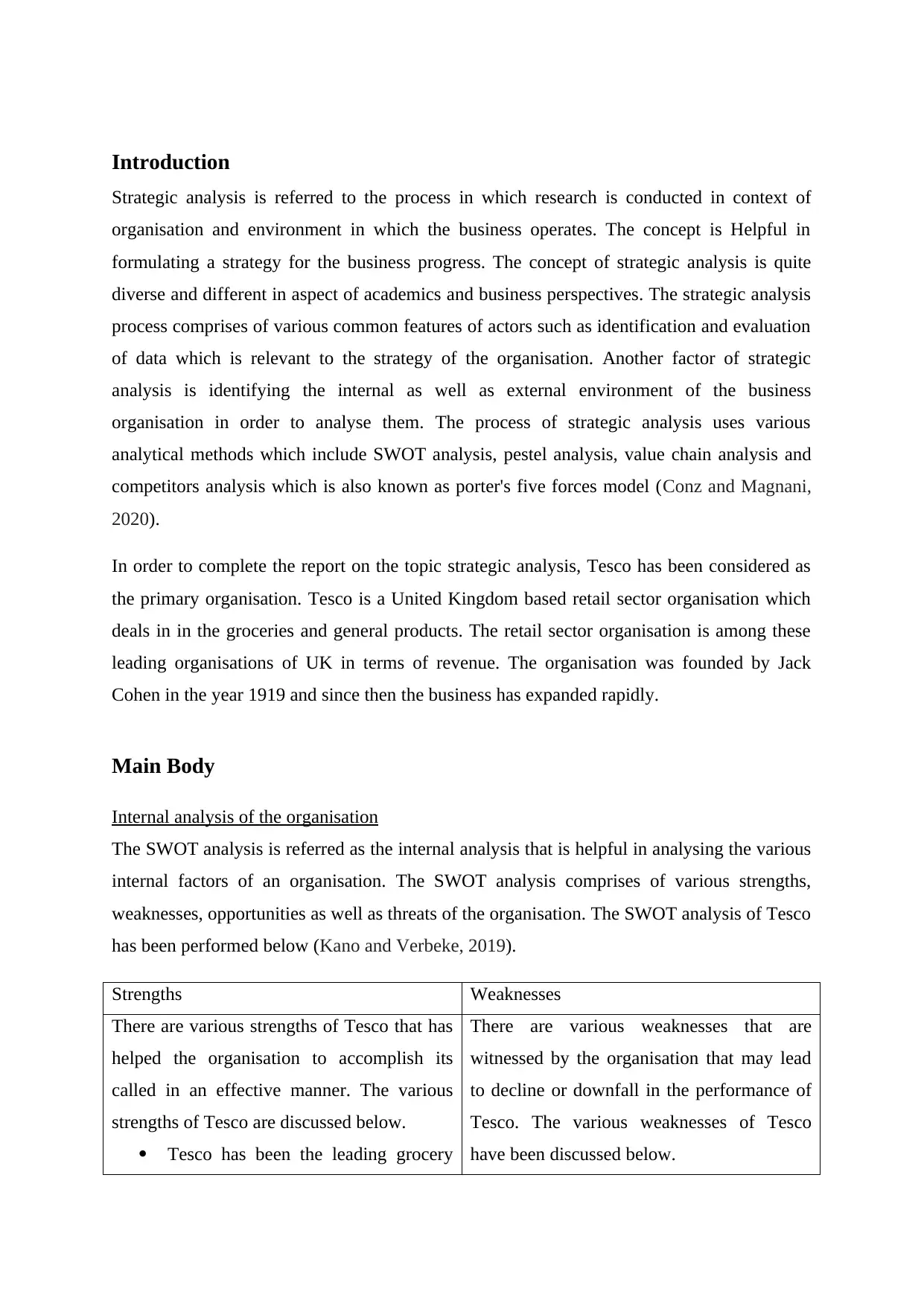
Introduction
Strategic analysis is referred to the process in which research is conducted in context of
organisation and environment in which the business operates. The concept is Helpful in
formulating a strategy for the business progress. The concept of strategic analysis is quite
diverse and different in aspect of academics and business perspectives. The strategic analysis
process comprises of various common features of actors such as identification and evaluation
of data which is relevant to the strategy of the organisation. Another factor of strategic
analysis is identifying the internal as well as external environment of the business
organisation in order to analyse them. The process of strategic analysis uses various
analytical methods which include SWOT analysis, pestel analysis, value chain analysis and
competitors analysis which is also known as porter's five forces model (Conz and Magnani,
2020).
In order to complete the report on the topic strategic analysis, Tesco has been considered as
the primary organisation. Tesco is a United Kingdom based retail sector organisation which
deals in in the groceries and general products. The retail sector organisation is among these
leading organisations of UK in terms of revenue. The organisation was founded by Jack
Cohen in the year 1919 and since then the business has expanded rapidly.
Main Body
Internal analysis of the organisation
The SWOT analysis is referred as the internal analysis that is helpful in analysing the various
internal factors of an organisation. The SWOT analysis comprises of various strengths,
weaknesses, opportunities as well as threats of the organisation. The SWOT analysis of Tesco
has been performed below (Kano and Verbeke, 2019).
Strengths Weaknesses
There are various strengths of Tesco that has
helped the organisation to accomplish its
called in an effective manner. The various
strengths of Tesco are discussed below.
Tesco has been the leading grocery
There are various weaknesses that are
witnessed by the organisation that may lead
to decline or downfall in the performance of
Tesco. The various weaknesses of Tesco
have been discussed below.
Strategic analysis is referred to the process in which research is conducted in context of
organisation and environment in which the business operates. The concept is Helpful in
formulating a strategy for the business progress. The concept of strategic analysis is quite
diverse and different in aspect of academics and business perspectives. The strategic analysis
process comprises of various common features of actors such as identification and evaluation
of data which is relevant to the strategy of the organisation. Another factor of strategic
analysis is identifying the internal as well as external environment of the business
organisation in order to analyse them. The process of strategic analysis uses various
analytical methods which include SWOT analysis, pestel analysis, value chain analysis and
competitors analysis which is also known as porter's five forces model (Conz and Magnani,
2020).
In order to complete the report on the topic strategic analysis, Tesco has been considered as
the primary organisation. Tesco is a United Kingdom based retail sector organisation which
deals in in the groceries and general products. The retail sector organisation is among these
leading organisations of UK in terms of revenue. The organisation was founded by Jack
Cohen in the year 1919 and since then the business has expanded rapidly.
Main Body
Internal analysis of the organisation
The SWOT analysis is referred as the internal analysis that is helpful in analysing the various
internal factors of an organisation. The SWOT analysis comprises of various strengths,
weaknesses, opportunities as well as threats of the organisation. The SWOT analysis of Tesco
has been performed below (Kano and Verbeke, 2019).
Strengths Weaknesses
There are various strengths of Tesco that has
helped the organisation to accomplish its
called in an effective manner. The various
strengths of Tesco are discussed below.
Tesco has been the leading grocery
There are various weaknesses that are
witnessed by the organisation that may lead
to decline or downfall in the performance of
Tesco. The various weaknesses of Tesco
have been discussed below.
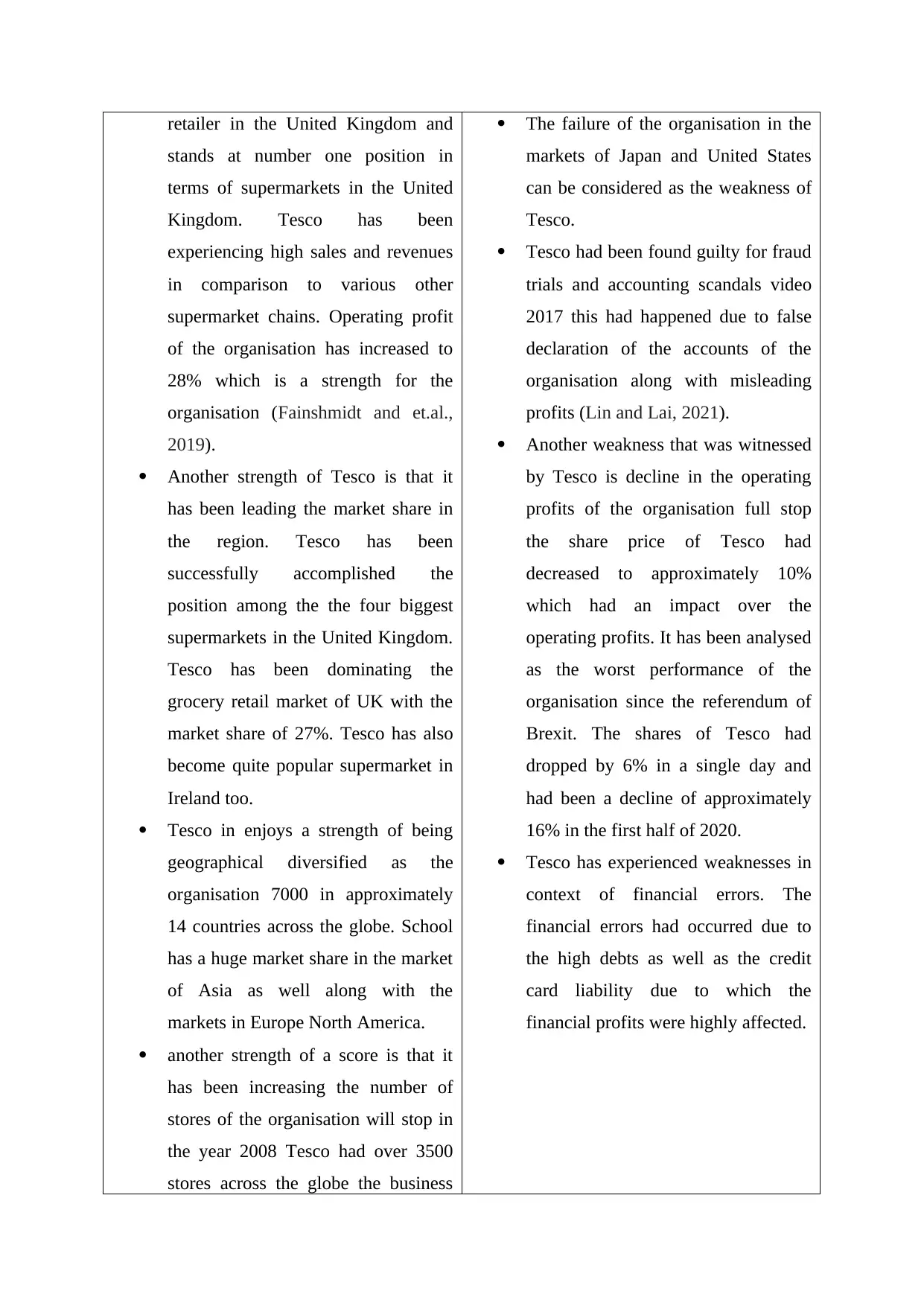
retailer in the United Kingdom and
stands at number one position in
terms of supermarkets in the United
Kingdom. Tesco has been
experiencing high sales and revenues
in comparison to various other
supermarket chains. Operating profit
of the organisation has increased to
28% which is a strength for the
organisation (Fainshmidt and et.al.,
2019).
Another strength of Tesco is that it
has been leading the market share in
the region. Tesco has been
successfully accomplished the
position among the the four biggest
supermarkets in the United Kingdom.
Tesco has been dominating the
grocery retail market of UK with the
market share of 27%. Tesco has also
become quite popular supermarket in
Ireland too.
Tesco in enjoys a strength of being
geographical diversified as the
organisation 7000 in approximately
14 countries across the globe. School
has a huge market share in the market
of Asia as well along with the
markets in Europe North America.
another strength of a score is that it
has been increasing the number of
stores of the organisation will stop in
the year 2008 Tesco had over 3500
stores across the globe the business
The failure of the organisation in the
markets of Japan and United States
can be considered as the weakness of
Tesco.
Tesco had been found guilty for fraud
trials and accounting scandals video
2017 this had happened due to false
declaration of the accounts of the
organisation along with misleading
profits (Lin and Lai, 2021).
Another weakness that was witnessed
by Tesco is decline in the operating
profits of the organisation full stop
the share price of Tesco had
decreased to approximately 10%
which had an impact over the
operating profits. It has been analysed
as the worst performance of the
organisation since the referendum of
Brexit. The shares of Tesco had
dropped by 6% in a single day and
had been a decline of approximately
16% in the first half of 2020.
Tesco has experienced weaknesses in
context of financial errors. The
financial errors had occurred due to
the high debts as well as the credit
card liability due to which the
financial profits were highly affected.
stands at number one position in
terms of supermarkets in the United
Kingdom. Tesco has been
experiencing high sales and revenues
in comparison to various other
supermarket chains. Operating profit
of the organisation has increased to
28% which is a strength for the
organisation (Fainshmidt and et.al.,
2019).
Another strength of Tesco is that it
has been leading the market share in
the region. Tesco has been
successfully accomplished the
position among the the four biggest
supermarkets in the United Kingdom.
Tesco has been dominating the
grocery retail market of UK with the
market share of 27%. Tesco has also
become quite popular supermarket in
Ireland too.
Tesco in enjoys a strength of being
geographical diversified as the
organisation 7000 in approximately
14 countries across the globe. School
has a huge market share in the market
of Asia as well along with the
markets in Europe North America.
another strength of a score is that it
has been increasing the number of
stores of the organisation will stop in
the year 2008 Tesco had over 3500
stores across the globe the business
The failure of the organisation in the
markets of Japan and United States
can be considered as the weakness of
Tesco.
Tesco had been found guilty for fraud
trials and accounting scandals video
2017 this had happened due to false
declaration of the accounts of the
organisation along with misleading
profits (Lin and Lai, 2021).
Another weakness that was witnessed
by Tesco is decline in the operating
profits of the organisation full stop
the share price of Tesco had
decreased to approximately 10%
which had an impact over the
operating profits. It has been analysed
as the worst performance of the
organisation since the referendum of
Brexit. The shares of Tesco had
dropped by 6% in a single day and
had been a decline of approximately
16% in the first half of 2020.
Tesco has experienced weaknesses in
context of financial errors. The
financial errors had occurred due to
the high debts as well as the credit
card liability due to which the
financial profits were highly affected.
Secure Best Marks with AI Grader
Need help grading? Try our AI Grader for instant feedback on your assignments.
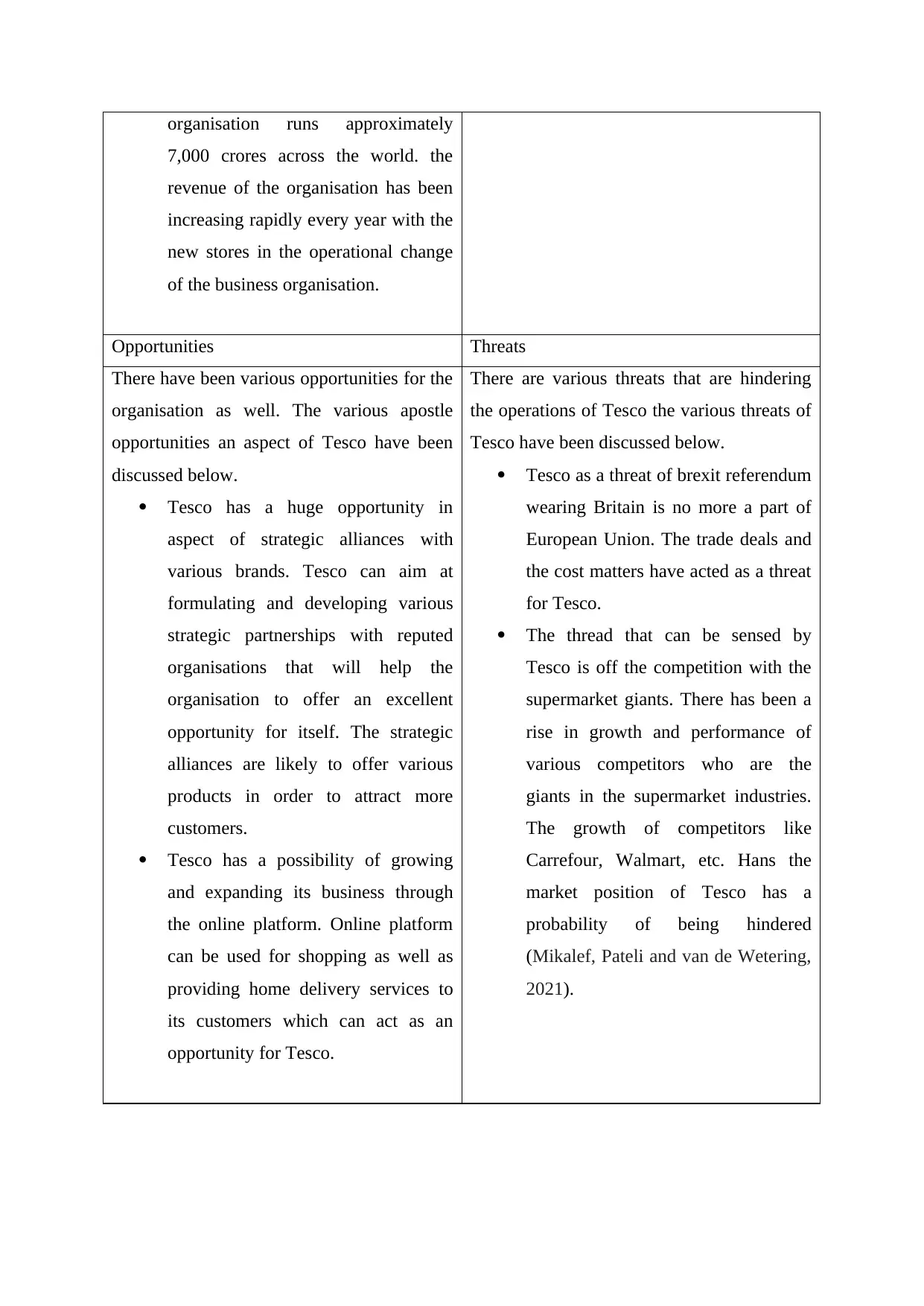
organisation runs approximately
7,000 crores across the world. the
revenue of the organisation has been
increasing rapidly every year with the
new stores in the operational change
of the business organisation.
Opportunities Threats
There have been various opportunities for the
organisation as well. The various apostle
opportunities an aspect of Tesco have been
discussed below.
Tesco has a huge opportunity in
aspect of strategic alliances with
various brands. Tesco can aim at
formulating and developing various
strategic partnerships with reputed
organisations that will help the
organisation to offer an excellent
opportunity for itself. The strategic
alliances are likely to offer various
products in order to attract more
customers.
Tesco has a possibility of growing
and expanding its business through
the online platform. Online platform
can be used for shopping as well as
providing home delivery services to
its customers which can act as an
opportunity for Tesco.
There are various threats that are hindering
the operations of Tesco the various threats of
Tesco have been discussed below.
Tesco as a threat of brexit referendum
wearing Britain is no more a part of
European Union. The trade deals and
the cost matters have acted as a threat
for Tesco.
The thread that can be sensed by
Tesco is off the competition with the
supermarket giants. There has been a
rise in growth and performance of
various competitors who are the
giants in the supermarket industries.
The growth of competitors like
Carrefour, Walmart, etc. Hans the
market position of Tesco has a
probability of being hindered
(Mikalef, Pateli and van de Wetering,
2021).
7,000 crores across the world. the
revenue of the organisation has been
increasing rapidly every year with the
new stores in the operational change
of the business organisation.
Opportunities Threats
There have been various opportunities for the
organisation as well. The various apostle
opportunities an aspect of Tesco have been
discussed below.
Tesco has a huge opportunity in
aspect of strategic alliances with
various brands. Tesco can aim at
formulating and developing various
strategic partnerships with reputed
organisations that will help the
organisation to offer an excellent
opportunity for itself. The strategic
alliances are likely to offer various
products in order to attract more
customers.
Tesco has a possibility of growing
and expanding its business through
the online platform. Online platform
can be used for shopping as well as
providing home delivery services to
its customers which can act as an
opportunity for Tesco.
There are various threats that are hindering
the operations of Tesco the various threats of
Tesco have been discussed below.
Tesco as a threat of brexit referendum
wearing Britain is no more a part of
European Union. The trade deals and
the cost matters have acted as a threat
for Tesco.
The thread that can be sensed by
Tesco is off the competition with the
supermarket giants. There has been a
rise in growth and performance of
various competitors who are the
giants in the supermarket industries.
The growth of competitors like
Carrefour, Walmart, etc. Hans the
market position of Tesco has a
probability of being hindered
(Mikalef, Pateli and van de Wetering,
2021).
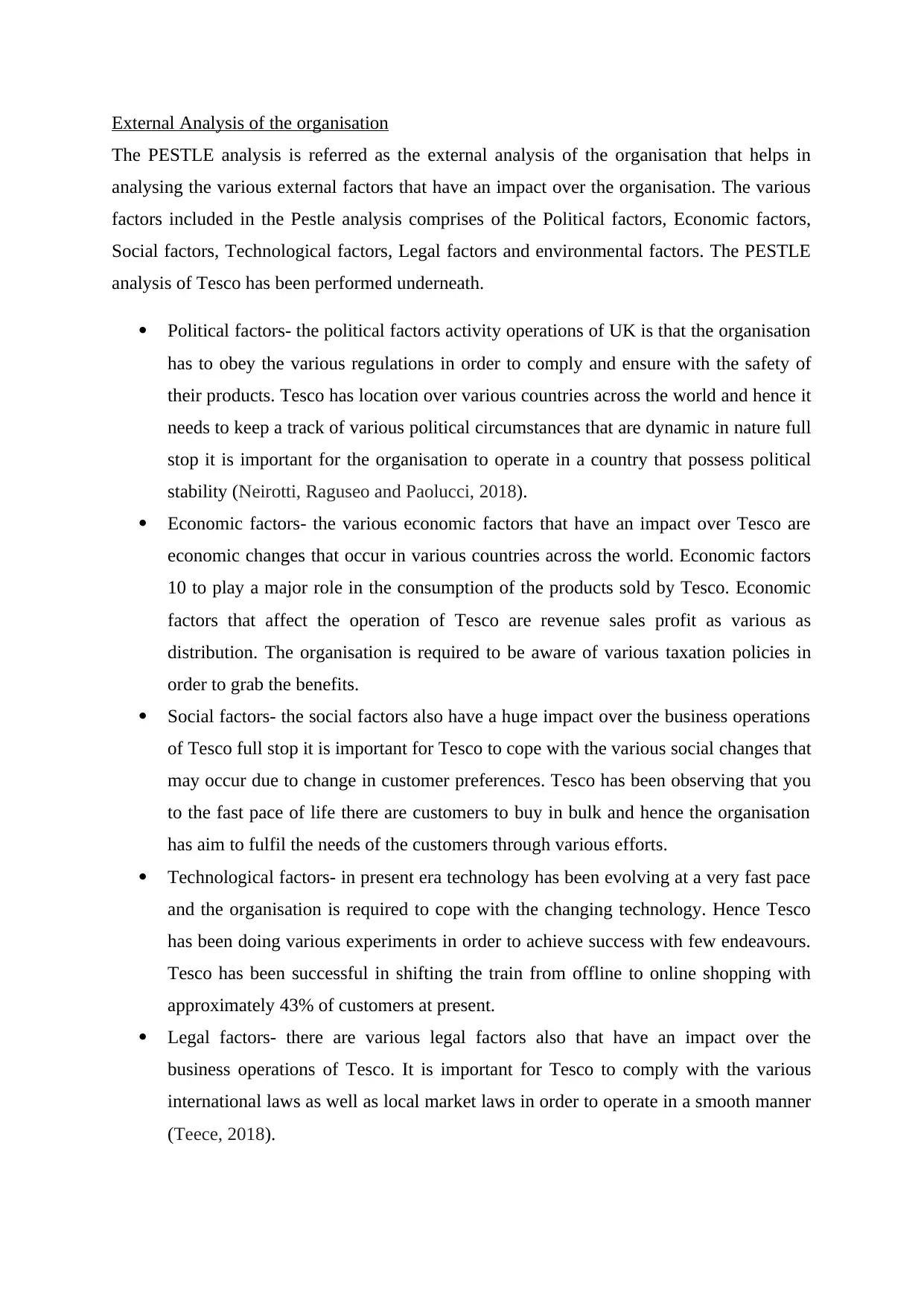
External Analysis of the organisation
The PESTLE analysis is referred as the external analysis of the organisation that helps in
analysing the various external factors that have an impact over the organisation. The various
factors included in the Pestle analysis comprises of the Political factors, Economic factors,
Social factors, Technological factors, Legal factors and environmental factors. The PESTLE
analysis of Tesco has been performed underneath.
Political factors- the political factors activity operations of UK is that the organisation
has to obey the various regulations in order to comply and ensure with the safety of
their products. Tesco has location over various countries across the world and hence it
needs to keep a track of various political circumstances that are dynamic in nature full
stop it is important for the organisation to operate in a country that possess political
stability (Neirotti, Raguseo and Paolucci, 2018).
Economic factors- the various economic factors that have an impact over Tesco are
economic changes that occur in various countries across the world. Economic factors
10 to play a major role in the consumption of the products sold by Tesco. Economic
factors that affect the operation of Tesco are revenue sales profit as various as
distribution. The organisation is required to be aware of various taxation policies in
order to grab the benefits.
Social factors- the social factors also have a huge impact over the business operations
of Tesco full stop it is important for Tesco to cope with the various social changes that
may occur due to change in customer preferences. Tesco has been observing that you
to the fast pace of life there are customers to buy in bulk and hence the organisation
has aim to fulfil the needs of the customers through various efforts.
Technological factors- in present era technology has been evolving at a very fast pace
and the organisation is required to cope with the changing technology. Hence Tesco
has been doing various experiments in order to achieve success with few endeavours.
Tesco has been successful in shifting the train from offline to online shopping with
approximately 43% of customers at present.
Legal factors- there are various legal factors also that have an impact over the
business operations of Tesco. It is important for Tesco to comply with the various
international laws as well as local market laws in order to operate in a smooth manner
(Teece, 2018).
The PESTLE analysis is referred as the external analysis of the organisation that helps in
analysing the various external factors that have an impact over the organisation. The various
factors included in the Pestle analysis comprises of the Political factors, Economic factors,
Social factors, Technological factors, Legal factors and environmental factors. The PESTLE
analysis of Tesco has been performed underneath.
Political factors- the political factors activity operations of UK is that the organisation
has to obey the various regulations in order to comply and ensure with the safety of
their products. Tesco has location over various countries across the world and hence it
needs to keep a track of various political circumstances that are dynamic in nature full
stop it is important for the organisation to operate in a country that possess political
stability (Neirotti, Raguseo and Paolucci, 2018).
Economic factors- the various economic factors that have an impact over Tesco are
economic changes that occur in various countries across the world. Economic factors
10 to play a major role in the consumption of the products sold by Tesco. Economic
factors that affect the operation of Tesco are revenue sales profit as various as
distribution. The organisation is required to be aware of various taxation policies in
order to grab the benefits.
Social factors- the social factors also have a huge impact over the business operations
of Tesco full stop it is important for Tesco to cope with the various social changes that
may occur due to change in customer preferences. Tesco has been observing that you
to the fast pace of life there are customers to buy in bulk and hence the organisation
has aim to fulfil the needs of the customers through various efforts.
Technological factors- in present era technology has been evolving at a very fast pace
and the organisation is required to cope with the changing technology. Hence Tesco
has been doing various experiments in order to achieve success with few endeavours.
Tesco has been successful in shifting the train from offline to online shopping with
approximately 43% of customers at present.
Legal factors- there are various legal factors also that have an impact over the
business operations of Tesco. It is important for Tesco to comply with the various
international laws as well as local market laws in order to operate in a smooth manner
(Teece, 2018).
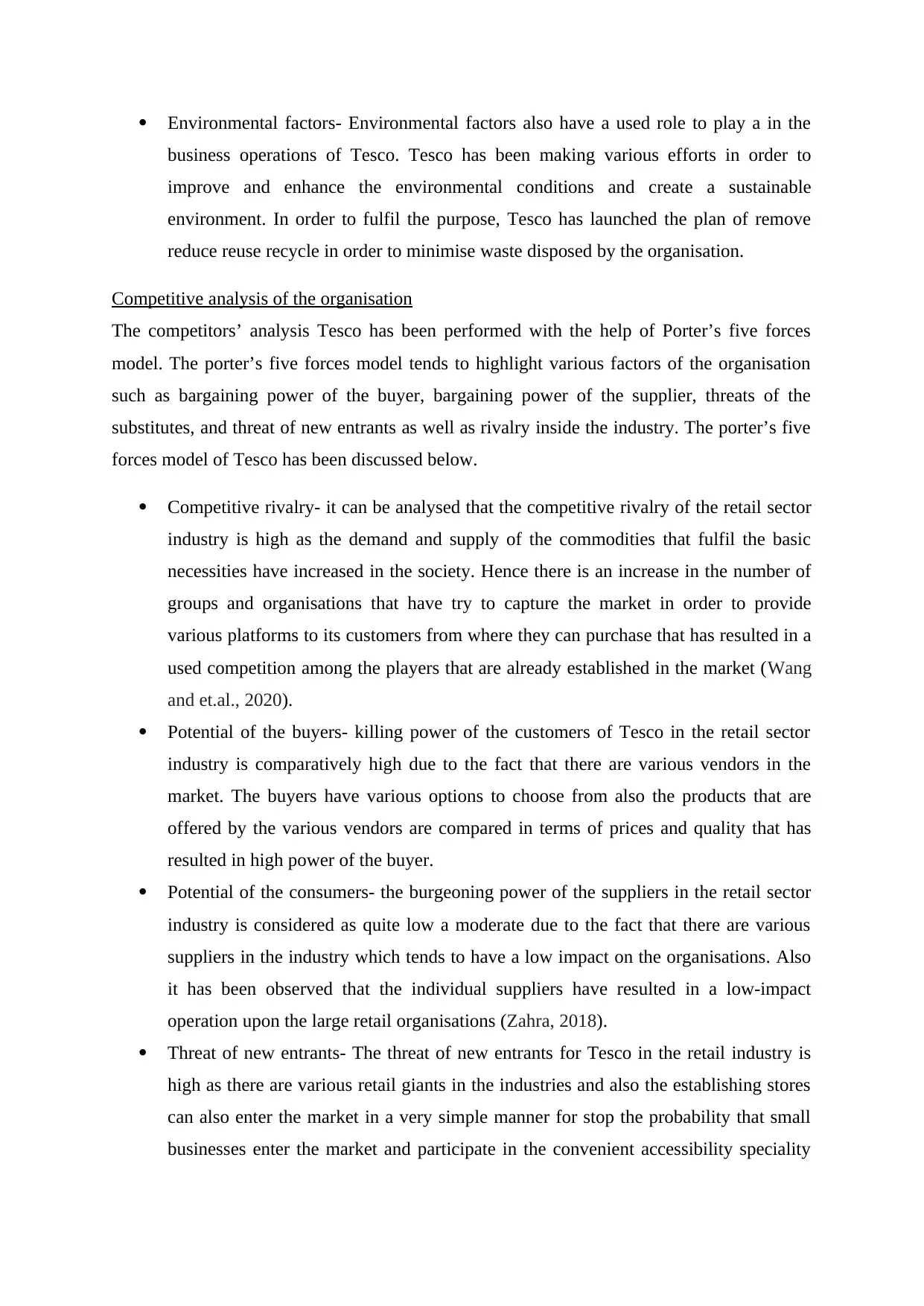
Environmental factors- Environmental factors also have a used role to play a in the
business operations of Tesco. Tesco has been making various efforts in order to
improve and enhance the environmental conditions and create a sustainable
environment. In order to fulfil the purpose, Tesco has launched the plan of remove
reduce reuse recycle in order to minimise waste disposed by the organisation.
Competitive analysis of the organisation
The competitors’ analysis Tesco has been performed with the help of Porter’s five forces
model. The porter’s five forces model tends to highlight various factors of the organisation
such as bargaining power of the buyer, bargaining power of the supplier, threats of the
substitutes, and threat of new entrants as well as rivalry inside the industry. The porter’s five
forces model of Tesco has been discussed below.
Competitive rivalry- it can be analysed that the competitive rivalry of the retail sector
industry is high as the demand and supply of the commodities that fulfil the basic
necessities have increased in the society. Hence there is an increase in the number of
groups and organisations that have try to capture the market in order to provide
various platforms to its customers from where they can purchase that has resulted in a
used competition among the players that are already established in the market (Wang
and et.al., 2020).
Potential of the buyers- killing power of the customers of Tesco in the retail sector
industry is comparatively high due to the fact that there are various vendors in the
market. The buyers have various options to choose from also the products that are
offered by the various vendors are compared in terms of prices and quality that has
resulted in high power of the buyer.
Potential of the consumers- the burgeoning power of the suppliers in the retail sector
industry is considered as quite low a moderate due to the fact that there are various
suppliers in the industry which tends to have a low impact on the organisations. Also
it has been observed that the individual suppliers have resulted in a low-impact
operation upon the large retail organisations (Zahra, 2018).
Threat of new entrants- The threat of new entrants for Tesco in the retail industry is
high as there are various retail giants in the industries and also the establishing stores
can also enter the market in a very simple manner for stop the probability that small
businesses enter the market and participate in the convenient accessibility speciality
business operations of Tesco. Tesco has been making various efforts in order to
improve and enhance the environmental conditions and create a sustainable
environment. In order to fulfil the purpose, Tesco has launched the plan of remove
reduce reuse recycle in order to minimise waste disposed by the organisation.
Competitive analysis of the organisation
The competitors’ analysis Tesco has been performed with the help of Porter’s five forces
model. The porter’s five forces model tends to highlight various factors of the organisation
such as bargaining power of the buyer, bargaining power of the supplier, threats of the
substitutes, and threat of new entrants as well as rivalry inside the industry. The porter’s five
forces model of Tesco has been discussed below.
Competitive rivalry- it can be analysed that the competitive rivalry of the retail sector
industry is high as the demand and supply of the commodities that fulfil the basic
necessities have increased in the society. Hence there is an increase in the number of
groups and organisations that have try to capture the market in order to provide
various platforms to its customers from where they can purchase that has resulted in a
used competition among the players that are already established in the market (Wang
and et.al., 2020).
Potential of the buyers- killing power of the customers of Tesco in the retail sector
industry is comparatively high due to the fact that there are various vendors in the
market. The buyers have various options to choose from also the products that are
offered by the various vendors are compared in terms of prices and quality that has
resulted in high power of the buyer.
Potential of the consumers- the burgeoning power of the suppliers in the retail sector
industry is considered as quite low a moderate due to the fact that there are various
suppliers in the industry which tends to have a low impact on the organisations. Also
it has been observed that the individual suppliers have resulted in a low-impact
operation upon the large retail organisations (Zahra, 2018).
Threat of new entrants- The threat of new entrants for Tesco in the retail industry is
high as there are various retail giants in the industries and also the establishing stores
can also enter the market in a very simple manner for stop the probability that small
businesses enter the market and participate in the convenient accessibility speciality
Paraphrase This Document
Need a fresh take? Get an instant paraphrase of this document with our AI Paraphraser
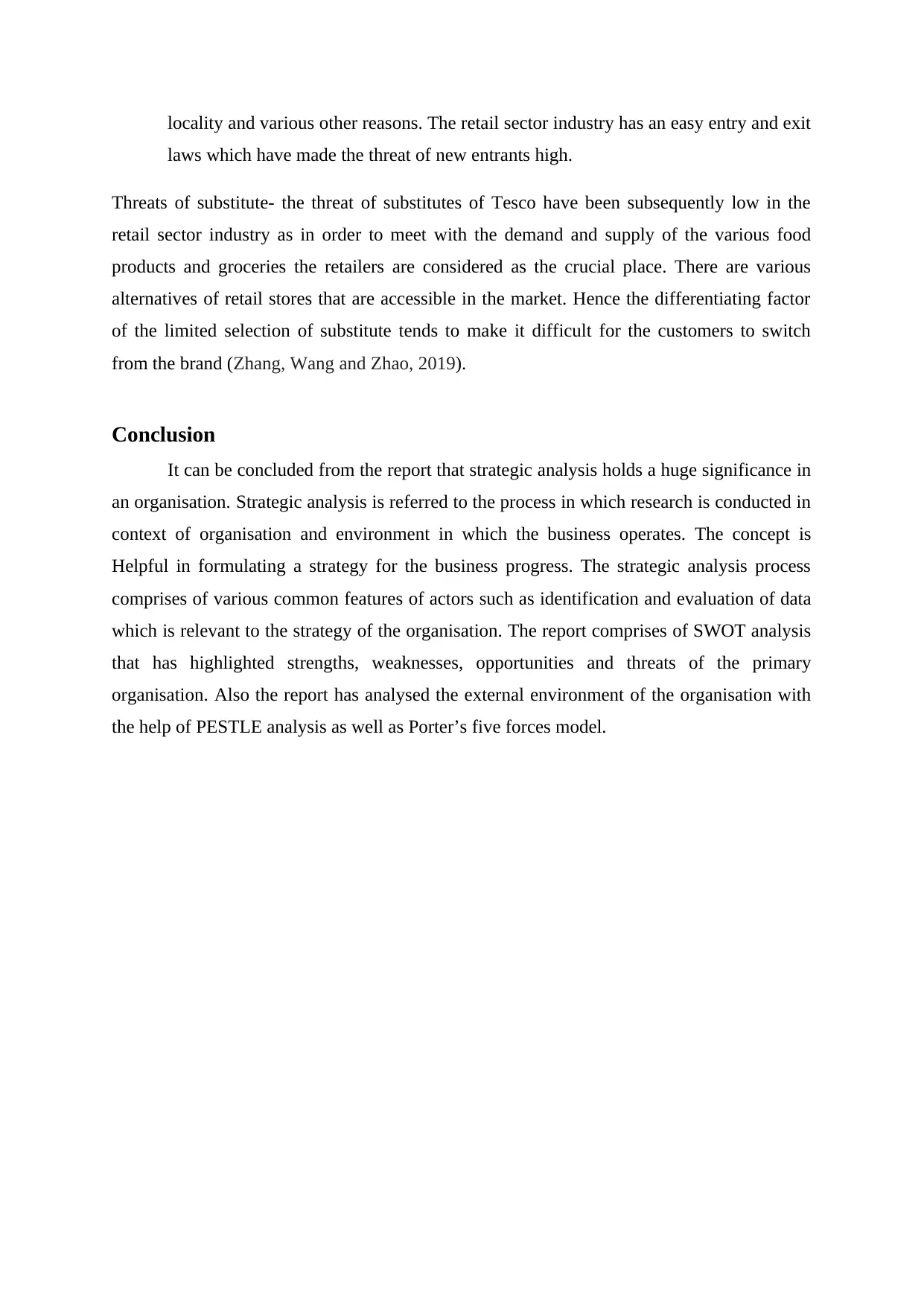
locality and various other reasons. The retail sector industry has an easy entry and exit
laws which have made the threat of new entrants high.
Threats of substitute- the threat of substitutes of Tesco have been subsequently low in the
retail sector industry as in order to meet with the demand and supply of the various food
products and groceries the retailers are considered as the crucial place. There are various
alternatives of retail stores that are accessible in the market. Hence the differentiating factor
of the limited selection of substitute tends to make it difficult for the customers to switch
from the brand (Zhang, Wang and Zhao, 2019).
Conclusion
It can be concluded from the report that strategic analysis holds a huge significance in
an organisation. Strategic analysis is referred to the process in which research is conducted in
context of organisation and environment in which the business operates. The concept is
Helpful in formulating a strategy for the business progress. The strategic analysis process
comprises of various common features of actors such as identification and evaluation of data
which is relevant to the strategy of the organisation. The report comprises of SWOT analysis
that has highlighted strengths, weaknesses, opportunities and threats of the primary
organisation. Also the report has analysed the external environment of the organisation with
the help of PESTLE analysis as well as Porter’s five forces model.
laws which have made the threat of new entrants high.
Threats of substitute- the threat of substitutes of Tesco have been subsequently low in the
retail sector industry as in order to meet with the demand and supply of the various food
products and groceries the retailers are considered as the crucial place. There are various
alternatives of retail stores that are accessible in the market. Hence the differentiating factor
of the limited selection of substitute tends to make it difficult for the customers to switch
from the brand (Zhang, Wang and Zhao, 2019).
Conclusion
It can be concluded from the report that strategic analysis holds a huge significance in
an organisation. Strategic analysis is referred to the process in which research is conducted in
context of organisation and environment in which the business operates. The concept is
Helpful in formulating a strategy for the business progress. The strategic analysis process
comprises of various common features of actors such as identification and evaluation of data
which is relevant to the strategy of the organisation. The report comprises of SWOT analysis
that has highlighted strengths, weaknesses, opportunities and threats of the primary
organisation. Also the report has analysed the external environment of the organisation with
the help of PESTLE analysis as well as Porter’s five forces model.
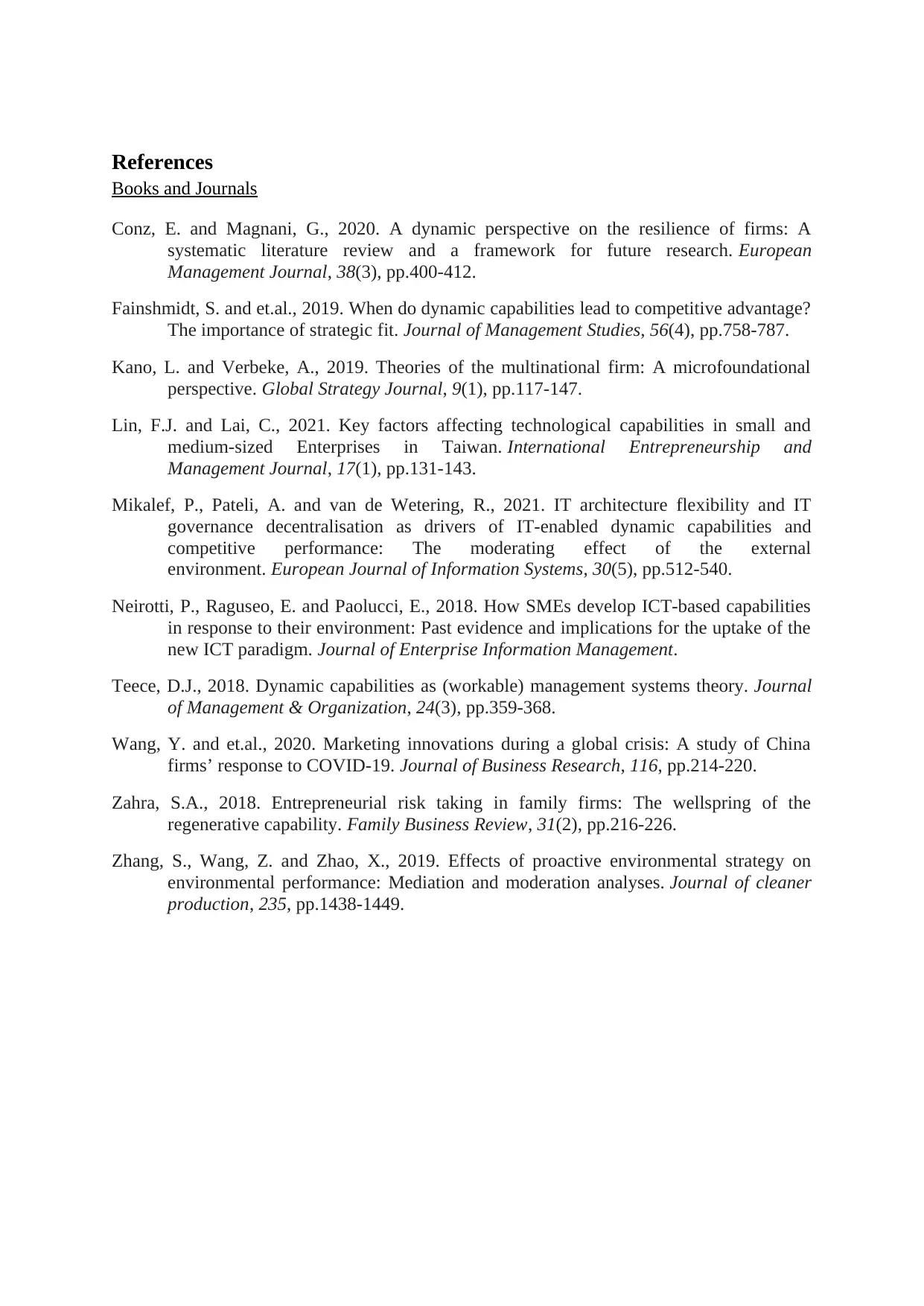
References
Books and Journals
Conz, E. and Magnani, G., 2020. A dynamic perspective on the resilience of firms: A
systematic literature review and a framework for future research. European
Management Journal, 38(3), pp.400-412.
Fainshmidt, S. and et.al., 2019. When do dynamic capabilities lead to competitive advantage?
The importance of strategic fit. Journal of Management Studies, 56(4), pp.758-787.
Kano, L. and Verbeke, A., 2019. Theories of the multinational firm: A microfoundational
perspective. Global Strategy Journal, 9(1), pp.117-147.
Lin, F.J. and Lai, C., 2021. Key factors affecting technological capabilities in small and
medium-sized Enterprises in Taiwan. International Entrepreneurship and
Management Journal, 17(1), pp.131-143.
Mikalef, P., Pateli, A. and van de Wetering, R., 2021. IT architecture flexibility and IT
governance decentralisation as drivers of IT-enabled dynamic capabilities and
competitive performance: The moderating effect of the external
environment. European Journal of Information Systems, 30(5), pp.512-540.
Neirotti, P., Raguseo, E. and Paolucci, E., 2018. How SMEs develop ICT-based capabilities
in response to their environment: Past evidence and implications for the uptake of the
new ICT paradigm. Journal of Enterprise Information Management.
Teece, D.J., 2018. Dynamic capabilities as (workable) management systems theory. Journal
of Management & Organization, 24(3), pp.359-368.
Wang, Y. and et.al., 2020. Marketing innovations during a global crisis: A study of China
firms’ response to COVID-19. Journal of Business Research, 116, pp.214-220.
Zahra, S.A., 2018. Entrepreneurial risk taking in family firms: The wellspring of the
regenerative capability. Family Business Review, 31(2), pp.216-226.
Zhang, S., Wang, Z. and Zhao, X., 2019. Effects of proactive environmental strategy on
environmental performance: Mediation and moderation analyses. Journal of cleaner
production, 235, pp.1438-1449.
Books and Journals
Conz, E. and Magnani, G., 2020. A dynamic perspective on the resilience of firms: A
systematic literature review and a framework for future research. European
Management Journal, 38(3), pp.400-412.
Fainshmidt, S. and et.al., 2019. When do dynamic capabilities lead to competitive advantage?
The importance of strategic fit. Journal of Management Studies, 56(4), pp.758-787.
Kano, L. and Verbeke, A., 2019. Theories of the multinational firm: A microfoundational
perspective. Global Strategy Journal, 9(1), pp.117-147.
Lin, F.J. and Lai, C., 2021. Key factors affecting technological capabilities in small and
medium-sized Enterprises in Taiwan. International Entrepreneurship and
Management Journal, 17(1), pp.131-143.
Mikalef, P., Pateli, A. and van de Wetering, R., 2021. IT architecture flexibility and IT
governance decentralisation as drivers of IT-enabled dynamic capabilities and
competitive performance: The moderating effect of the external
environment. European Journal of Information Systems, 30(5), pp.512-540.
Neirotti, P., Raguseo, E. and Paolucci, E., 2018. How SMEs develop ICT-based capabilities
in response to their environment: Past evidence and implications for the uptake of the
new ICT paradigm. Journal of Enterprise Information Management.
Teece, D.J., 2018. Dynamic capabilities as (workable) management systems theory. Journal
of Management & Organization, 24(3), pp.359-368.
Wang, Y. and et.al., 2020. Marketing innovations during a global crisis: A study of China
firms’ response to COVID-19. Journal of Business Research, 116, pp.214-220.
Zahra, S.A., 2018. Entrepreneurial risk taking in family firms: The wellspring of the
regenerative capability. Family Business Review, 31(2), pp.216-226.
Zhang, S., Wang, Z. and Zhao, X., 2019. Effects of proactive environmental strategy on
environmental performance: Mediation and moderation analyses. Journal of cleaner
production, 235, pp.1438-1449.
1 out of 9
Related Documents
Your All-in-One AI-Powered Toolkit for Academic Success.
+13062052269
info@desklib.com
Available 24*7 on WhatsApp / Email
![[object Object]](/_next/static/media/star-bottom.7253800d.svg)
Unlock your academic potential
© 2024 | Zucol Services PVT LTD | All rights reserved.





